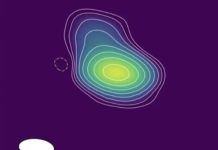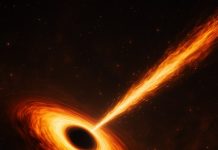
When doing the marketing for the James Webb Space Telescope (JWST), NASA and the other telescope contributors liked to point out how it would open up the early universe to scrutiny.
They weren’t exaggerating, and now scientific studies are starting to proliferate that show why.
A new study published by authors from Harvard, the University of Arizona, and the University of Cambridge used three surveys produced by the JWST to analyze the supermassive black holes at the center of early galaxies.
And they found they were much different than the one at the center of our own, at least in terms of relative size.
Fabio Pacuci and his coauthors were looking at galaxies located 12-13 billion light years away – some of the earliest formed ones in the universe.
In particular, they were looking at the size of the black holes in the center of those galaxies compared to the size of the stars the galaxies are composed of.
For example, the ratio of the weight of stars to the weight of the supermassive black hole in the center of our home Milky Way Galaxy is about 1000 to 1 – meaning the total mass of the stars outweighs the black hole by a factor of 1000. Similar ratios have been found for other galaxies with similar ages, such as Andromeda.
However, the study found something quite different in older galaxies. Their ratios were more like 100 to 1 or even as low as 1 to 1, where the supermassive black hole weighed as much as all of the stars orbiting it.
This difference has “important implications for the study of the first population of black holes,” according to Xiaofui Fan, one of the study’s coauthors, as mentioned in a recent press release.
There has been an ongoing discussion about those early black holes, focused primarily on what the precursors of the supermassive black holes we know today looked like.
Two competing theories have taken root for those precursors – “heavy” seeds and “light” seeds. In the “heavy” seed scenario, the seed materials for the supermassive black hole would mass around 10,000 to 100,000 times the mass of our Sun, while “light” seeds would weigh in at about 100 to 1,000 times.
According to the new paper, the “heavy” seed model is more likely. It would be more likely to create large supermassive black holes, such as those seen in the JWST data, by allowing the accumulation of material from giant gas clouds to coalesce around a much larger starting mass.
Simulations of this seed theory also predicted that the black holes in early galaxies would roughly mass the same as the galaxies they were surrounded by.
As any good scientist will tell you, if a theory or a model makes a stunning different prediction, and further data collection aligns with that prediction, then it’s a very good sign for the theory. That is precisely what happened in the case of the heavy seed theory and the JWST data.
As described in the paper, the data closely fits the prediction made by heavy-seed modelers.
But it’s not quite an open-and-shut case yet. Many astronomers still don’t know about the early black hole formation process.
But JWST isn’t done yet, and the paper’s authors are hopeful that further data releases will help shed light on how those seeds grow into fully-fledged black holes and what that means for how the universe was more generally formed.
For now, they’ll have to wait for some more data. But with JWST still going strong, it seems there will be plenty more papers peering into the early universe enabled by humanity’s most impressive space telescope.
Written by Andy Tomaswick/Universe Today.



